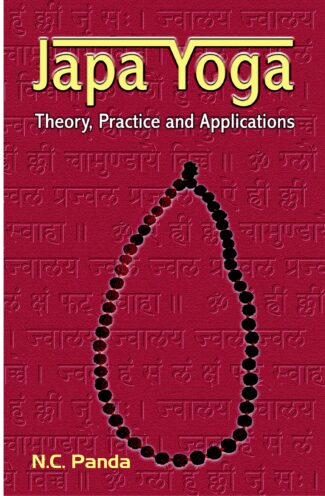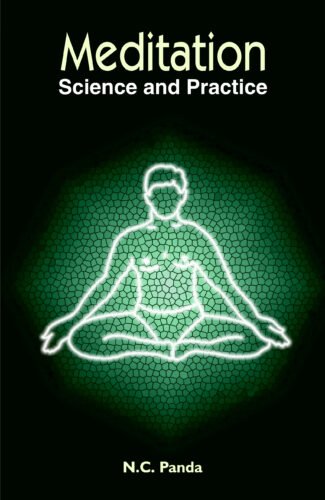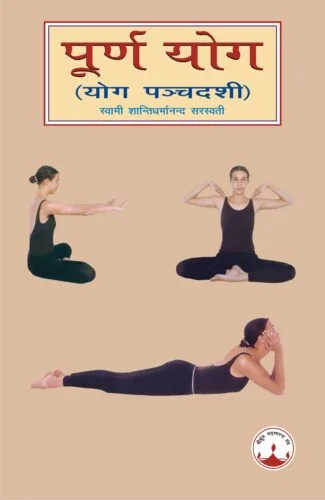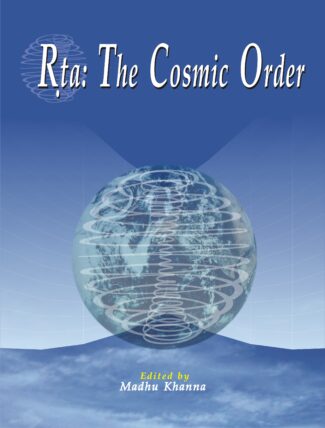Showing 13–24 of 34 results

The repetition of God’s name or of a mantra containing God’s name, otherwise known as japa, is a religious ritual, generally meant for the emancipation of the self. This book on japa-yoga has not neglected this aspect. But, it is a more comprehensive and a broad-range booking effects of japa-applications on a scientific footing, a successful attempt made for the first time.
The repetition of Gods name or of a mantra containing Gods name, otherwise known as japa, is a religious ritual, generally meant for the emancipation of the self. The present book on japa-yoga has not neglected this aspect. But, it is a more comprehensive and a broad-range book. That japa is a branch of yoga, an easily attainable one and simultaneously a very effective one, has been emphasized. The theory and methology of japa in Patanjala Yoga, in the Vedas, in the Vedanta and in the Tantra, in the perspective of knowledge and devotion, have clearly been outlined. The book has been divided into three Chapters. Chapter 1 expounds the theory of japa based on classical scriptures. Chapter 2 presents the practice of japa in a clearly graspable style, easy to be followed by the readers. Chapter 3 deals with the applications of japa for the uplift of human personality and spirituality, for attaining the liberation of the self, for mental peace and tranquillity, and for physical health inclusive of the prevention and treatment of diseases, both physical and mental. The last part of this book tries to explain the effects of japa-applications on a scientific footing, a successful attempt made for the first time.

The repetition of God’s name or of a mantra containing God’s name, otherwise known as japa, is a religious ritual, generally meant for the emancipation of the self. This book on japa-yoga has not neglected this aspect. But, it is a more comprehensive and a broad-range booking effects of japa-applications on a scientific footing, a successful attempt made for the first time.
The repetition of Gods name or of a mantra containing Gods name, otherwise known as japa, is a religious ritual, generally meant for the emancipation of the self. The present book on japa-yoga has not neglected this aspect. But, it is a more comprehensive and a broad-range book. That japa is a branch of yoga, an easily attainable one and simultaneously a very effective one, has been emphasized. The theory and methology of japa in Patanjala Yoga, in the Vedas, in the Vedanta and in the Tantra, in the perspective of knowledge and devotion, have clearly been outlined. The book has been divided into three Chapters. Chapter 1 expounds the theory of japa based on classical scriptures. Chapter 2 presents the practice of japa in a clearly graspable style, easy to be followed by the readers. Chapter 3 deals with the applications of japa for the uplift of human personality and spirituality, for attaining the liberation of the self, for mental peace and tranquillity, and for physical health inclusive of the prevention and treatment of diseases, both physical and mental. The last part of this book tries to explain the effects of japa-applications on a scientific footing, a successful attempt made for the first time.

Diabetes is a malice threatening the very existence of the modern society. This book educates one how to diagnose type 1 and type 2 diabetes, how to test them, what all precautions are needed, how to deal with diabetes during pregnancy, what is diabetic foot and how to care it, the available medicines and their effects, what all exercises one should do to control diabetes, diet specifications, precautions to be taken while travelling, among many other pieces of information, that help a diabetic to lead a normal life.
India is under the grip of a malady called Diabetes. According to WHO and International Diabetes Federation (IDF), India is all set to become the diabetic capital of the world. Of the 31 crore estimated diabetic patients all over the world, India has more than six crore people affected with this disease. This book addresses many an issue faced by the diabetic patients, both type 1 and type 2. It thus provides detailed information on the genesis, restraints and cure, short- and long-term effects of diabetes. It also addresses a number of challenges associated with diabetes.
In a wide spectrum, the book talks about this silent killer and its symptoms, diagnosis, monitoring of blood glucose, its treatment, desired exercises to keep diabetes under control, changes needed in lifestyle to combat diabetes, diet on special occasions, sugar tablets, herbal medicines, insulin therapy, how to face emergency situations in diabetes, complications due to diabetes, relationship between diabetes and (1) heart disease, (2) eyesight problems, and (3) kidney disorders. It also delves deep into the implications of diabetic foot, fluctuations in body weight due to this disease, other common ailments in diabetics, targets of controlling diabetes, pregnancy and diabetes, travelling with diabetes, need of routine diabetic examination and tests, impact of alcohol on a diabetic, diabetes in children and the aged, guidelines for fasting, etc.
The book also educates one on what to eat and what not, to keep diabetes under control. A detailed diet chart with calorie calculation is also given for a diabetic to follow in day-to-day life. In addition, it provides quite a lot of data related to our physical fitness, be it weight, height, food recommendations for non-veg people, or calorie value conversion of different food items. In a nutshell, this guidebook is a must-need for a diabetic and must-read for his family members as there is no permanent cure available for diabetes as yet, and its management is equally important like its treatment.
Mahāmudrā and Atiyoga are particular forms of Buddhist spirituality: Mahāmudrā, the ‘Great Seal’, is considered by Tibetan teachers to be the essence of both the short path and the final instructions that conclude the gradual common and esoteric paths of Buddhist doctrines; Atiyoga or ‘Extreme Union’ represents the Buddhist Dzogchen or ‘Great Completeness’ doctrine.
This volume comprises commentaries on and the transliteration of some ancient Tibetan texts, authored by Buddhist mystics and Tāntric teachers of Mahāmudrā and Atiyoga.
Translated from the Italian, the book is based on oral instructions received by the author from Tibetan teachers. It discusses the insights of the sacred texts and the commentaries on them with respect to the nature of consciousness and phenomenal existence, meditation on guru and deity, Tāntric sexuality, and the introduction to and realization of non-dual awareness.
Simple to understand, the commentaries explain the many meanings of the texts and the symbols and images used. They motivate readers to observe for themselves and personally experience the significance of the traditions and the application of their methods of practice.
The volume will be useful to all students and scholars of Buddhist studies, particularly of the Buddhist Tàntric tradition, and of Tibetan religion and culture.

Prof. Panda discusses the eight limbs of Patanjala Yoga, emphasizing on meditation in its three stages of dharana, dhyana and samadhi. Delving into Patnnjalis classical yogic theories, he gives detailed guidelines on the practice of meditation and explains in scientific terms the benefits surfacing from the practice of meditation.
Yoga, contrary to the popular perception, is not merely a system of physical culture. It is, in fact, a uniquely Indian discipline aiming to bring about the union of an individual spirit with the Universal Spirit: the Cosmic Consciousness through what in Yoga is known as samadhi, a state of profound meditation. Patanjalis Yoga-sutram, written sometime around the second century bc, is the first, systematic, at once authoritative presentation of Yoga: in both its theoretical and practical aspects. Professor N. C. Panda, who has had a lifetime involvement with the science and practice of Yoga, here outlines the eight limbs of Patanjala Yoga, with added emphasis on meditation in all its three stages: dharana, dhyana, and samadhi; and how this ancient system of bodily and mental control is found to have a strong scientific basis. Offered in three parts, his book focuses, in Part 1, on the practice of meditation, with detailed guidelines concerning the relevant yogic postures, yogic breathing and breath-control. Part 2 presents Patanjalis classical yogic theories, showing how these are validated: both theoretically and experimentally, by modern science. In Part 3, the author explains, in pure scientific terms, the physical, psychic, therapeutic and spiritual benefits surfacing from the practice of meditation. Though based on the principles of classical yoga, Professor Pandas book is truly a brilliant effort to treat Yoga as an advanced science. Including a comprehensive glossary of Sanskrit technical terms and numerous illustrations, it is invaluable to medical scientists/researchers/anyone interested in Yogic Meditation and how it can give a holistic, healthy and creative life.

Prof. Panda discusses the eight limbs of Patanjala Yoga, emphasizing on meditation in its three stages of dharana, dhyana and samadhi. Delving into Patnnjalis classical yogic theories, he gives detailed guidelines on the practice of meditation and explains in scientific terms the benefits surfacing from the practice of meditation.
Yoga, contrary to the popular perception, is not merely a system of physical culture. It is, in fact, a uniquely Indian discipline aiming to bring about the union of an individual spirit with the Universal Spirit: the Cosmic Consciousness through what in Yoga is known as samadhi, a state of profound meditation. Patanjalis Yoga-sutram, written sometime around the second century bc, is the first, systematic, at once authoritative presentation of Yoga: in both its theoretical and practical aspects. Professor N. C. Panda, who has had a lifetime involvement with the science and practice of Yoga, here outlines the eight limbs of Patanjala Yoga, with added emphasis on meditation in all its three stages: dharana, dhyana, and samadhi; and how this ancient system of bodily and mental control is found to have a strong scientific basis. Offered in three parts, his book focuses, in Part 1, on the practice of meditation, with detailed guidelines concerning the relevant yogic postures, yogic breathing and breath-control. Part 2 presents Patanjalis classical yogic theories, showing how these are validated: both theoretically and experimentally, by modern science. In Part 3, the author explains, in pure scientific terms, the physical, psychic, therapeutic and spiritual benefits surfacing from the practice of meditation. Though based on the principles of classical yoga, Professor Pandas book is truly a brilliant effort to treat Yoga as an advanced science. Including a comprehensive glossary of Sanskrit technical terms and numerous illustrations, it is invaluable to medical scientists/researchers/anyone interested in Yogic Meditation and how it can give a holistic, healthy and creative life.

Yoga is a serious and a comprehensive subject. It is difficult to bring completeness in it. Swami Shanti Dharmanand has tried to give the complete information on health and yoga beginning at its initial stage. Different forms of yogic postures with their health benefits have been mentioned in detail.
Yoga is a deep and extensive topic to explain, and attaining absolute perfection in it is extremely difficult. Swami Shantidharmananda Saraswati has however tried to enrich this concise book with complete information for a beginner, a patient and even for an expert. He has shed into it his intellect and experience of Upanishadic and literary sources matching with scientific research besides the basic knowledge obtained from his Guru and Rishis. Though this book has been written by taking ashtanga-yoga as a base, all types of asanas and procedures of yoga have been accommodated in a disciplined manner. Secrets of hathayoga, rajayoga, kriyayoga, japayoga, layayoga, kundalini yoga, nadayoga, svarayoga, etc. have been summarized in brief. This is the reason why it has been named as Purna Yoga. Since all the topics related to yoga have been divided into fifteen chapters, this book has been referred to as Yoga Pancadashi as well. Purna Yoga is a guide for a blissful life as well as a very useful tool for every individual in the society.
The founding fathers of the quantum revolution were deeply invested in questions of meaning. Distanced from theology but also from the deterministic objective Materialism of the classical model of physics, several of them, including Bohr, Heisenberg, Pauli, Schrödinger and Bohm looked to Eastern philosophies for explanations. This search for meaning beyond church and clockwork seems to have stagnated in our times. Yet, recent advances in physics and the reinterpretation of historic experiments have given us new ways to understand and ask fundamental philosophical questions. These approaches include further considerations of the Copenhagen Interpretation of Bohr, Heisenberg and others, the Transactional Interpretation of John G. Cramer and Ruth Krastner, Quantum Bayesianism (QBism) of Fuchs, Schack and David Mermin; questions related to the meaning of observation and measurement; the Orthodox view of quantum mechanics; collapse of the wave function and time and quantum field theory. The present volume brings together a number of these approaches discussed by leading contemporary physicists. It also expands the consideration of the quantum revolution to include its larger implications for philosophy, mathematics, biology and global understanding, reopening the questions of consciousness and meaning which occupied the minds of the early thinkers of Quantum Mechanics.

This book looks at recent developments in the sciences and the humanities taking into account many disciplines. The integral approach suggests radical departures by presenting alternate paradigms to the consumeristic paradigm which governs humankind today.
This book by an anthropologist looks at recent developments in the sciences and the humanities taking into account many disciplines. The integral approach suggests radical departures by presenting alternate paradigms to the consumeristic paradigm which governs humankind today. This reconceptualizing through a rethinking is the only way a shift in lifestyles can be brought about if we wish to avoid the disasters which are upon us in terms of the oftstated ecological, socio-economic, psychological and spiritual crises. The implications of science in the new age are crucial for the growth and relevance of those disciplines which study the human phenomenon. By and large, in these academic disciplines general concepts have neglected the role of Consciousness which is a must in any integral approach.
Each chapter is governed by this overall context, as it is exemplified in the different topics dealt with from the viewpoint of many disciplines. The argument is not a linear sequential one, and in this sense each chapter is self-contained especially because the basic premise is that it is both the observer and the observed which have to be thoroughly understood at the particular and the universal levels. Science itself is moving into metaphysics, converging well into mystical insights and ancient speculative thought. The various themes of the book are: Civilization Studies and Knowledge: A Holistic Approach; Rock Art: A Creative Act; Man in Nature: An Integral Universe; A Question of Consciousness; Science and Consciousness; Violence and Non-Violence: A Binary System; and Integral Listening as Communication.

The articles trace the genesis of the concept of dharma in the Rgvedic concept of cosmic order or rta and relate other aspects of socio-cultural-religious life to the construction of order and its underlying vision. Comparing notions of order in Hindu, Buddhist, Chinese and Islamic speculative thought, they explain the relevance of understanding the concept of rta in the present day.
In the Rig Veda there is a remarkable insight on the notion of Rita or Cosmic Order, the inflexible law of universal order and harmony whereby all disorders and chaos is restored to equilibrium. Rita is, in essence, the ordering principle of nature which gives to everything from the vast galaxies, down to the nucleus of an atom, their nature and course. In the Vedic vision, this law of cosmic order is conceived to be manifesting at three levels: on the cosmic plane Rita governs the course of nature; on the socio-ethical level, Rita imparts justice; and on the religio-spiritual level, Rita mirrored the ritual performances of the sacrificial ritual (yajna). Rita contributes to the maintenance of balance between the micro and macro levels of existence. The articles, presentations at a seminar, trace the genesis of the concept of dharma in rita and relate other aspects of socio-cultural-religious life like food and eating customs, cultural communication and religious narratives to the construction of order and its underlying vision. They importantly examine the elements and relationships that create the cognition of order in temporal and spatial expressions of the arts. In this book, a panel of distinguished Indian and foreign scholars interpret this multifaceted theme of Rita from a wide range of perspectives. Comparing notions of order in Hindu, Buddhist, Chinese and Islamic speculative thought and with references to ancient Indian Hindu writings and modern science. Combining sound scholarship with a penetrating insight, these essays are a fine example of integrated studies. They give alternative viewpoints on the unity underlying this ancient concept as well as, its relevance in the modern age.

The book throws light on the structural, philosophical and scientific perspectives of mandala designs of temples, and explores the relationship between spiritual ideas and the ideas of scientific advancement as exhibited in the mandalas of ancient temples.
Indian temples are a rich repository of the religious, cultural, and artistic life of the society. Of special importance here are the circular, intricate, and artistic patterns called the mandalas, which are placed in the bhuvaneshvari of the temple that is conceived as the microcosmic representation of the cosmos in a temple.
The study of the significance of the mandalas are based on the aspects like symbolism, fractals, numerology, and sacred geometry that are used as codes to reveal the mystery of the universe and the eternal laws that govern the order of the universe. The diagrams of mandalas, concealing vast and grandest knowledge of science and spirituality in an amalgamation, are condensed to simplest graphic designs so that the knowledge of science was accessible to the commoners. The study presents the structural, philosophical and scientific perspectives of some mandalas belonging to the early Calukya, late Calukya and the Hoysala temples of south India. The research work also explores the study of the Golden ratios on which the mandalas and the divine images of the temples are designed.
The book will prove extremely absorbing to scholars concerned with the study of the art and architecture of the ancient divine sculptures.

A compilation of seminar papers by Indian and foreign experts brings alive ancient Indian developments in science, technology and medicine. The book presents Vedic quest in science and metaphysics with a special emphasis on ancient science and contemporary ideas.
The volume comprises seminar presentations by experts from India and abroad involved in the study of development of the natural sciences in ancient India. It offers eighteen papers from the seminar that showcase and project the Vedic literature as a treasure trove of vast knowledge that covers various branches of learning. The papers in particular discuss the ancient developments in science and technology: logic, mechanics in Sanskrit literature, Indian mathematics and its application in the Vedas, besides production technology and mechanical engineering, environmental science and roots, applicative wonders and scientific validation of Ayurveda. They involve a deep study of the Vedic understanding and description of sound and speech as para, pashyanti, madhyama and vaikhari. They also deal with the Indian perspective on the spirit and some mahakavyas of Indian philosophy. They scrutinise various theories on matter, causation, metals, dreams and motion, according to the Vaisheshika philosophy and underline the relevance of ancient knowledge to the contemporary world, especially in relation to the Vedic physics, environmental science and Ayurveda. They reiterate in unison the scientific vision of the ancient sages who held the keen eye of a poet-artist even while bringing to light modern and advanced ideas. The papers include references to various commentaries and studies on scientific and mathematical treatises, like Katyayana’s Shulbasutra and Vaimanikashastra of Bharadvaja.
The book will interest Indologists, particularly concerned with the study of ancient science, technology and mathematics, as they evolved in ancient India.